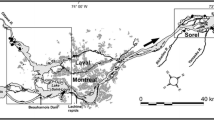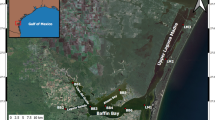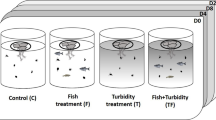Abstract
We test the hypothesis that phytoplankton biomass decrease upon entry into the St. Lawrence River from headwaters in Lake Ontario is attributable to a range of causal factors including, decreased photosynthetic fitness due to turbulence, cell loss due to increased flocculation and subsequent sedimentation, decreases in nutrients, and loss due to grazing. In order to test this, changes in phytoplankton and crustacean zooplankton concentrations were examined during four transects along the river, from 8 km offshore in Lake Ontario to the hydroelectric power dam 180 km downstream. Both phytoplankton biomass, measured as chlorophyll-a, and zooplankton decreased markedly upon entry of lake water into the river. Phytoplankton community composition and size changed little over the river reach and tended to reflect that in Lake Ontario. Total phosphorus increased with transit of river water downstream despite low tributary inputs of water into this reach of river. Light availability was high, photosynthetic efficiency suggested that phytoplankton were not physiologically stressed during transit in turbulent waters, and there was no direct evidence of flocculation causing sedimentation of phytoplankton. Grazing by the benthic community (filtering insect larvae and dreissenid mussels) is inferred to be a dominant biological factor as is the geomorphology in this reach of the river, which includes large littoral areas, shoals, and reaches of high water velocity that can increase particle contact in the water column with benthic grazers. The findings of this study have a bearing on understanding how changing water levels in a regulated river might alter areas of benthic grazing.








Similar content being viewed by others
References
Basu, B. K., J. Kalff & B. Pinel-Alloul, 2000a. Midsummer plankton development along a large temperate river: the St. Lawrence River. Canadian Journal of Fisheries and Aquatic Sciences 57: 7–15.
Basu, B. K., J. Kalff & B. Pinel-Alloul, 2000b. The influence of macrophyte beds on plankton communities and their export from fluvial lakes in the St Lawrence River. Hydrobiologia 45: 373–382.
Beutler, M., K. H. Wilstshire, B. Meyer, C. Moldaenke, C. Lüring, M. Meyerhöfer, U.-P. Hansen & H. Dau, 2002. A fluorometric method for the differentiation of algal populations in vivo and in situ. Photosynthesis Research 72: 39–53.
Chandler, D. C., 1937. Fate of typical lake plankton in streams. Ecological Monographs 7: 445–479.
Dobson, H. F. H., 1990. Some observations of (non-toxic) chemicals in water samples from the St. Lawrence River from Kingston to Québec. National Water Research Institute, Contribution No. 90-19.
Gouvêa, S. P., C. Melendez, M. J. Carberry, G. S. Bullerjahn, S. W. Wilhelm, T. A. Langen & M. R. Twiss, 2006. Assessment of phosphorus–microbe interactions in Lake Ontario by multiple techniques. Journal of Great Lakes Research 32: 455–470.
Hudon, C., S. Paquet & V. Jarry, 1996. Downstream variations of phytoplankton in the St Lawrence River (Québec, Canada). Hydrobiologia 337: 11–26.
Kolber, Z. & P. G. Falkowski, 1993. Use of active fluorescence to estimate phytoplankton photosynthesis in situ. Limnology and Oceanography 38: 1646–1665.
Landry, M. R. & R. P. Hassett, 1982. Estimating the grazing impact of micro-zooplankton. Marine Biology 67: 283–288.
Lewis, M. R., E. P. W. Horne, J. J. Cullen, N. S. Oakey & T. Platt, 1984. Turbulent motions may control phytoplankton photosynthesis in the upper ocean. Nature 311: 49–50.
Litchman, E. D., D. Steiner & P. Bossard, 2003. Photosynthetic and growth responses of three freshwater algae to phosphorus limitation and daylength. Freshwater Biology 48: 2141–2148.
Millard, E. S., D. D. Myles, O. E. Johannsson & K. M. Ralph, 1996. Seasonal phosphorus deficiency of Lake Ontario phytoplankton at two index stations: light versus phosphorus limitation of growth. Canadian Journal of Fisheries and Aquatic Science 53: 1112–1124.
Mills, E. L. & J. L. Forney, 1982. Response of Lake Ontario plankton entering the international section of the St. Lawrence River. Internationale Revue der gesamten Hydrobiologie 67: 27–43.
Pemberton, K. L., R. E. H. Smith, G. M. Silsbe, T. Howell & S. B. Watson, 2007. Controls on phytoplankton physiology in Lake Ontario during the late summer: evidence from new fluorescence methods. Canadian Journal of Fisheries and Aquatic Sciences 64: 58–73.
Reynolds, C. S., 2000. Hydroecology of river plankton: the role of variability in channel flow. Hydroecological Processes 15: 3119–3132.
Ruiz, J., D. Macías & F. Peters, 2004. Turbulence increases the average settling velocity of phytoplankton cells. Proceedings of the National Academy of Sciences (USA) 101: 17720–17724.
Twiss, M. R., 2007. Wither the St. Lawrence River? Journal of Great Lakes Research 33: 693–698.
Walks, D. J. & H. Cyr, 2004. Movement of plankton through lake-stream systems. Freshwater Biology 49: 745–759.
Welker, M. & N. Walz, 1998. Can mussels control the plankton in rivers? – a planktological approach applying a Lagrangian sampling strategy. Limnology & Oceanography 42: 753–762.
Welschemeyer, N. A. 1994. Fluorometric analysis of chlorophyll a in the presence of chlorophyll b and phaeopigments. Limnology & Oceanography 39: 1985–1992.
Wetzel, R. G. & G. E. Likens, 2000. Limnological Analyses, 3rd ed. Springer-Verlag, New York.
Wilhelm, S. W., J. M. DeBruyn, O. Gillor, M. R. Twiss, K. Livingston, R. A. Bourbonniere, L. D. Pickell, C. G. Trick, A. L. Dean & R. M. L. McKay, 2003. Effect of phosphorus amendments on present day plankton communities in pelagic Lake Erie. Aquatic Microbial Ecology 32: 275–285.
Acknowledgments
This research was supported by grants from the New York Power Authority (St. Lawrence River Research and Education Fund). Student support was provided by the National Science Foundation—Research Experience for Undergraduates (C. Ulrich, J. Harold), the Ronald E. McNair Post-Baccalaureate Achievement Program (S. Kring), and the U.S. Environmental Protection Agency Greater Research Opportunities for Undergraduates fellowship program (M. R. Williams). We thank K. Gloska, T. Kohanski, H. Lockwood, and A. Twiss for assistance in the field, and anonymous reviewers for comments that improved the manuscript. This is Contribution No. 352 of the Clarkson University Center for the Environment.
Author information
Authors and Affiliations
Corresponding author
Additional information
Guest editors: M. Power, J. Marty, M. R. Twiss, J. Ridal, Y. de Lafontaine, J. M. Farrell / St. Lawrence River–Great Lakes Ecosystems: An Ecological Overview
Rights and permissions
About this article
Cite this article
Twiss, M.R., Ulrich, C., Kring, S.A. et al. Plankton dynamics along a 180 km reach of the Saint Lawrence River from its headwaters in Lake Ontario. Hydrobiologia 647, 7–20 (2010). https://doi.org/10.1007/s10750-010-0115-0
Received:
Accepted:
Published:
Issue Date:
DOI: https://doi.org/10.1007/s10750-010-0115-0




